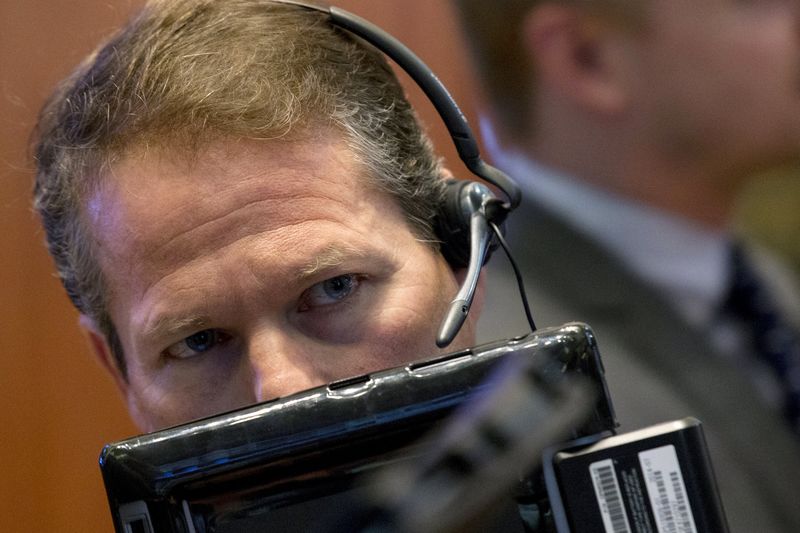* Deutsche Bank shares fall 8 percent to below 10 euros
* End of quarter, upcoming data adds to jitters
* Euro hits 8-week low vs safe-haven Swiss franc
* Oil pulls back after two day surge
* Only two stock markets set of quarterly fall
* Oil pulls back after Thursday gains on OPEC supply curb
By Marc Jones
LONDON, Sept 30 (Reuters) - An eight percent slump in Deutsche Bank's already battered share price sent Europe into a fresh tailspin on Friday and left world equity markets sliding toward their worst week in three months.
Germany's biggest lender, Deutsche, hit by a string of fines for wrongdoing and a sharp fall in its revenues, saw its shares drop below 10 euros for the first time in its history DBKGn.DE in a brutal European open. followed reports that a number of hedge funds that clear derivatives trades with Deutsche had withdrawn some of their cash and adjusted positions, a sign that counterparties were becoming wary of doing business with it.
The turbulence spilled into currency and bond markets again too with the euro falling to a two-month low of 1.081 against the safe-haven Swiss franc EURCHF= and buyers flocked to German government bonds DE10YT=TWEB driving down their yields.
"It is fear itself," National Australia Bank's London-based Global Head of Forex Nick Parsons said about the Deutsche Bank angst.
"The problem is we have had previous experiences of bank failures and they are still very fresh in the memory and it is making for a very nervous backdrop."
As if that wasn't enough, markets were at traditionally illiquid end-of-quarter point and for those investors who run their books September to September it was the even tighter end- of-year crunch time.
In a sea of red, London's FTSE 100 .FTSE was down 1 percent, Germany's DAX .GDAXI and France's CAC 40 .FCHI both fell 1.5 percent while banks across Europe .SX7E were down 4 percent and almost 6.5 percent for the week.
Britain's sterling GBP=D4 was heading for its fifth consecutive quarter of losses against the dollar in the currency markets - its worst run since 1984 - as concerns about the UK's Brexit plans, or lack of, have continued to bite.
There were still some positives to hold on to. For the quarter, only two stock markets look to be set for losses - Mongolia and the Philippines.
Latin America, and Brazil in particular, remains the star performer. Sao Paulo stocks have seen another 15 percent jump this quarter taking their gains for the year to a whopping 62 percent. L8N1C571K
DATA DELUGE
Overnight, MSCI's broadest index of Asia-Pacific shares outside Japan .MIAPJ0000PUS lost 1 percent. But it is poised for a 1.7 percent gain in September, and a 9 percent jump in the third quarter.
A raft of data out of the United States next week is also contributing to market jitters, with the chance of a Federal Reserve interest rate hike in December still seen at around 50-50.
Numbers to watch include September manufacturing and August construction spending data on Monday, non-manufacturing indexes for September and August factory orders on Wednesday and non-farm payrolls for September on Friday.
"People are very nervous going in to next week, with risk factors including the U.S. election and economy, with payrolls coming out next week," said Stefan Worrall, director of Japan equity sales at Credit Suisse (SIX:CSGN) in Tokyo. "So it's normal to expect volatility in an air pocket of uncertainty."
Japan's Nikkei .N225 closed down 1.5 percent after weaker-than-expected consumption and inflation data. It recorded a loss of 2.6 percent for the month, but ended the quarter up 5.6 percent.
While industrial output beat expectations in August, that did little to lift pressure on the central bank to ease monetary conditions further.
Some Bank of Japan board members doubted whether the central bank's overhaul of its massive stimulus programme, announced last week, would enhance flexibility of monetary policy, a summary of opinions at the central bank's September rate review showed on Friday. CSI 300 index .CSI300 bucked the regional trend to rise 0.3 percent, paring losses for the month to 2.1 percent.
China's factory activity inched up in September, in line with analyst forecasts, but growth was tepid. Output expanded in September but at the slowest pace in three months. markets are closed for the National Day holiday all next week.
Oil prices pulled back after rising 7 percent in two days after OPEC agreed to its first output cuts in eight years.
Even if production is scaled back, some analysts doubted the reduction would be enough to make a substantial dent in the global crude glut.
"The accord has not yet defined individual quotas or other forms of accountability, suggesting that this is a soft output cut at best," Francisco Blanch, commodity and derivatives strategist at Bank of America Merrill Lynch (NYSE:BAC), wrote in a note.
"OPEC's action won't propel prices much above our $70 mid-year target," he added.
U.S. crude futures CLc1 slipped 0.8 percent to $47.48. They closed up 1.7 percent at $47.83 on Thursday, after climbing to as high as $48.32, the highest level in almost five weeks. They're on track for gains of 6.2 percent in September.
